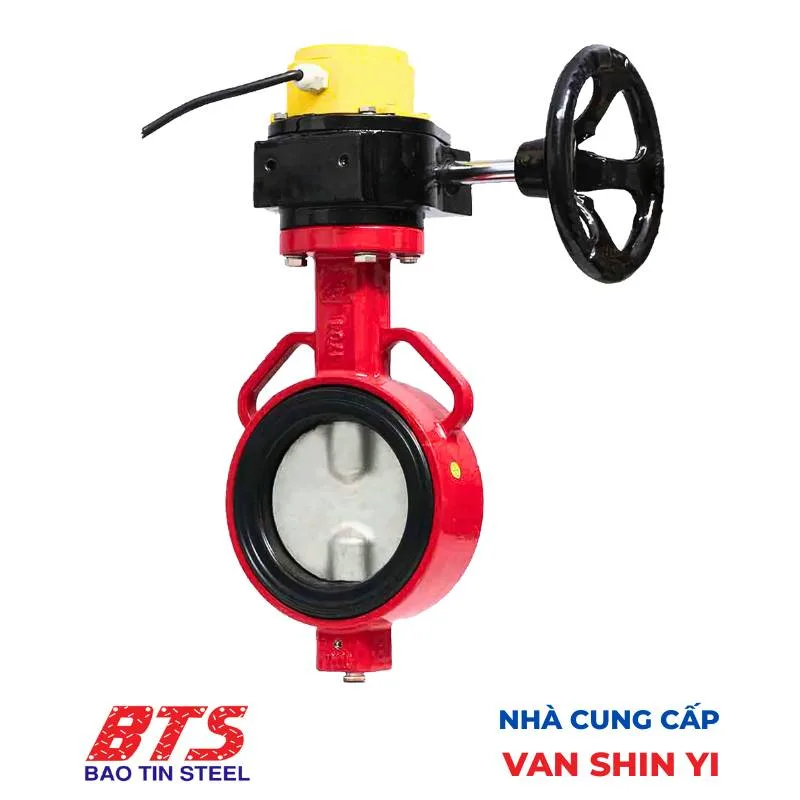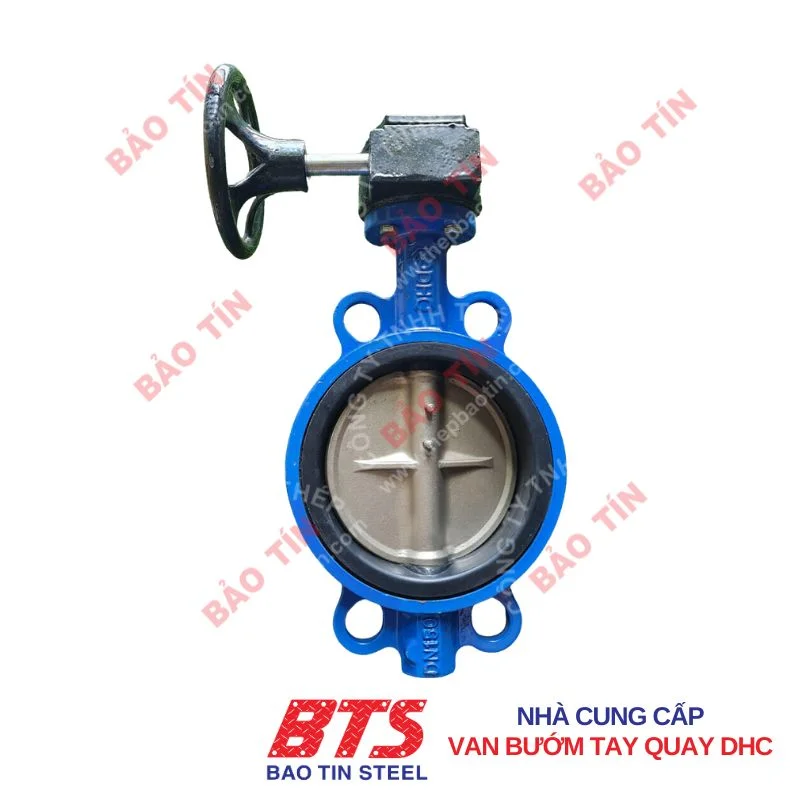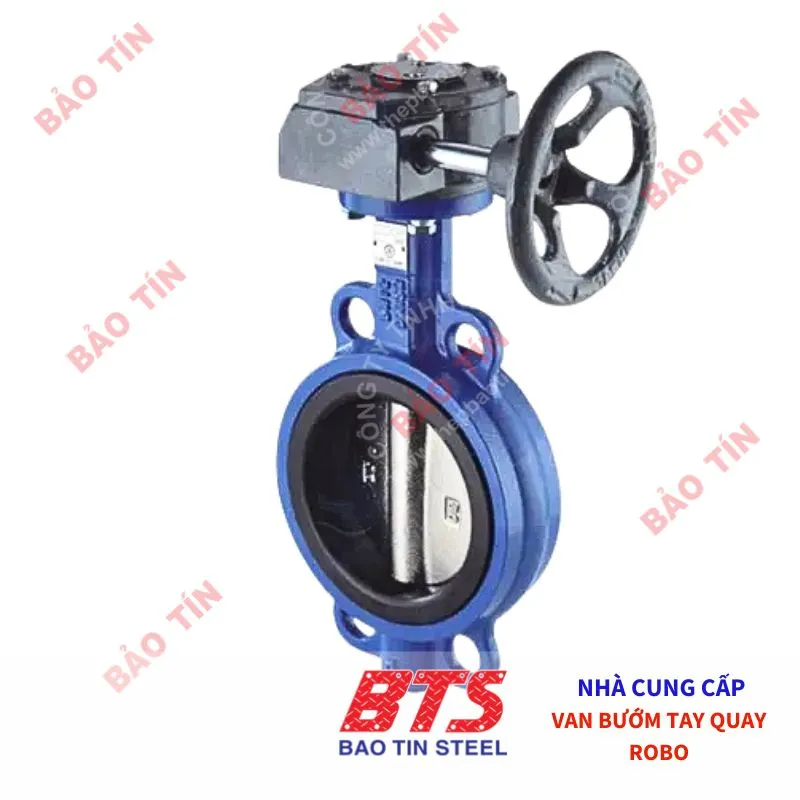In the era of Industry 4.0, automating pipeline systems has become essential for boosting efficiency and reducing operating costs. One widely used device in current water supply and drainage systems, HVAC, chemical processing, and production lines is the electric butterfly valve.
Unlike manual lever valves or pneumatic valves, electric butterfly valves can automatically open/close or regulate flow thanks to their smart electric actuators. This device not only optimises operational processes but also ensures accuracy and safety in industrial environments.
So, what exactly is an electric butterfly valve? What are its structure, operating principles, and key considerations when choosing one? The following article will provide you with a comprehensive understanding from A to Z.
What is an electric butterfly valve?
An electric actuated butterfly valve (or motorised butterfly valve) is a type of industrial butterfly valve used to control the flow rate of liquids, gases, or steam through an automatic open/close or regulating mechanism, thanks to an electric actuator.
The main structure of the valve consists of two parts:
Valve Body (Butterfly Valve Body)
- This includes the valve disc (butterfly disc), stem (shaft), body, and sealing gasket.
Electric Actuator (Electric Controller)
- This component receives control signals from the system (PLC, DCS, or control switches) and converts them into mechanical motion to rotate the valve stem
Electric butterfly valves can operate in ON/OFF mode (fully open/closed) or linear mode (modulating angle), making them suitable for systems requiring automation, high precision, and stable operation.
With their flexible connectivity with SCADA systems, BMS, or central control cabinets, electric butterfly valves are increasingly becoming an indispensable solution in smart factories and modern industrial systems.
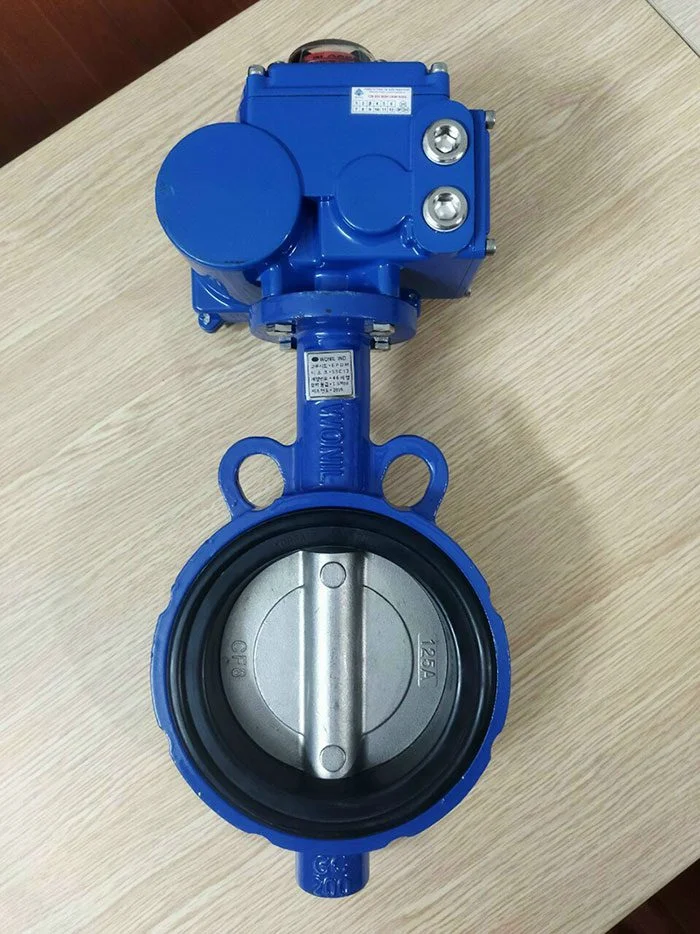
Detailed structure of the electric control butterfly valve
Electrically operated butterfly valves consist of two main parts: the butterfly valve body and the electric actuator. Each component has its role and is designed to ensure stable operation in automated industrial systems.
Butterfly valve body
This is the part that directly contacts the medium and performs the function of opening/closing the flow. The main parts include:
- Valve Disc (Butterfly Disc): This is the round or oval-shaped component that rotates around the stem to adjust flow. Common materials include stainless steel 304/316, ductile iron, PVC plastic, or steel.
- Valve Stem: This transmits motion from the actuator to the valve disc. The stem is typically made from stainless steel or hardened steel, providing good torsional strength.
- Valve Body (Outer Casing): This encloses the entire internal mechanism, securing the valve to the pipeline. Materials can include cast iron, steel, aluminium, or plastic.
- Sealing Gasket (Seat): This ensures a tight seal when the valve is closed. It can be made from EPDM, PTFE (Teflon), Viton, or NBR, depending on the fluid medium and operating temperature.
Electric Controller (Electric Actuator)
This is the central control part that helps the valve operate automatically, including:
- Electric Motor: This is the core component that converts electrical energy into rotational motion, driving the valve’s operation.
- Gearbox (Reducer): The gearbox increases torque, allowing the valve disc to rotate smoothly and stably, even under high-pressure conditions.
- Limit Switches: These switches define the fully open and fully closed positions, cutting off power to the motor once the desired position is reached to prevent over-rotation.
- Control Circuit & Display: This sophisticated part receives control signals (like ON/OFF commands or analogue signals such as 4-20mA or 0-10V). It can also integrate status indicators or feedback signals to report the valve’s current position or operational status.
- Manual Override (Optional Handwheel): This is a handy optional feature used for manual operation in case of power failure, ensuring the valve can still be opened or closed when electricity isn’t available.
The actuator typically meets IP65 to IP68 dust and water resistance standards, ensuring reliable operation in humid or chemical industrial environments.
Operating Principle of Electric Butterfly Valves
Electric butterfly valves operate on the principle of converting electrical signals into mechanical motion to rotate the valve’s disc, thereby controlling the flow within a pipeline.
Basic Operation Process
When the control system sends an electrical signal (typically 24VDC, 220VAC, or 380VAC), the electric motor inside the actuator begins to rotate. This force is then transmitted through a gearbox (reducer) to increase torque.
This rotational force is then transferred to the valve stem, causing the valve disc (butterfly disc) to rotate a specific angle—usually up to a maximum of 90 degrees:
- When the disc is parallel to the flow, the valve is fully open.
- When the disc is perpendicular to the flow, the valve is fully closed.
- With linear valves, the disc stops at an intermediate angle (30°, 45°, 60°…) to regulate the flow.
Protection and safety
- The actuator incorporates a limit switch to automatically shut off when the valve reaches
- its open or closed limit, avoiding motor overload. Some models also have a mechanical handwheel for manual operation in the event of a power outage.
With its flexible and precise operating mechanism, electrically controlled butterfly valves are gradually replacing manual valves in modern automation systems.
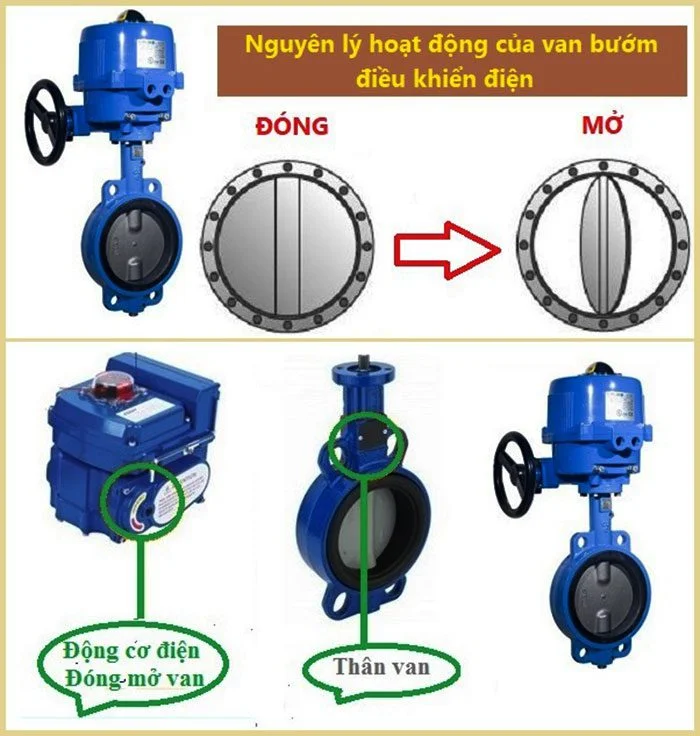
Classification of Electric Butterfly Valves
Electric butterfly valves can be classified in various ways, but the most common classifications are based on their control function and construction material.
Classification by Control Function
- ON/OFF Electric Butterfly Valve: These valves have only two states: fully closed or fully open. They are suitable for water supply and drainage systems, fire protection (PCCC), and water pumping applications where precise flow regulation is not required.
- Linear (Modulating) Electric Butterfly Valve: These valves are capable of adjusting their opening angle from 0–90° according to analogue control signals (4-20mA, 0-10V). They are ideal for HVAC systems, chemical processing, and food industries where accurate flow control is essential.
- Smart Electric Butterfly Valve: These valves integrate a microprocessor, enabling network communication (Modbus, BACnet), status display, and configuration via software or NFC. They are used in smart factories, SCADA, and BMS systems.
Classification by Valve Body Material
- Cast Iron Electric Butterfly Valve: Economical and commonly used in clean water and wastewater systems.
- Stainless Steel Electric Butterfly Valve (Inox 304/316): Offers good corrosion resistance, suitable for chemical environments, seawater, and food applications.
- Plastic Electric Butterfly Valve (PVC, UPVC, CPVC, PP, PVDF): Lightweight and corrosion-resistant, ideal for chemical systems and water treatment.
- Steel/Aluminium Butterfly Valve: Used in high-pressure and high-temperature environments.
- Brass Butterfly Valve: Less common, used in specialised systems.

Classification by Connection Type
- Wafer Type (Clamped between two flanges): Easy to install, cost-effective, and the most common type.
- Lug Type (with threaded bolt holes): Allows for the removal of one side of the pipeline without affecting the other.
- Flanged Type: Installed using bolts and nuts. Ensures a high degree of sealing, suitable for large pipelines and high-pressure systems.
Classification by Control Voltage
- 24VDC: Commonly used in small-scale automatic control systems, offering high safety.
- 110VAC / 220VAC: Widely prevalent in industrial and residential applications, easy to power.
- 380VAC: Designated for high-power systems and heavy industrial motors.
Practical Applications of Electric Butterfly Valves
With their automation capabilities, stable operation, and precise control, electric butterfly valves are widely used across various industrial and civil sectors. Here are some typical applications:
- Controlling the inlet and outlet water flow in water supply, drainage, and wastewater treatment systems.
- In the chemical, pharmaceutical, and food industries, for precise fluid handling.
- Regulating hot/cold water or air flow in HVAC systems: This includes chillers, cooling towers, AHU (Air Handling Units), FCU (Fan Coil Units), and ventilation ducts. They integrate with BMS/SCADA systems for monitoring and energy-saving control.
- Electric butterfly valves with signal feedback (featuring status monitoring switches) are commonly used in: Sprinkler systems, fire extinguishing water supply pipelines, and zone control valves.
- Controlling the flow of oil, gas, steam, wet coal, or cooling water in power plants, refineries, and mining operations.
- Marine water pumping and wastewater treatment systems on ships.
- Controlling compressed air in mechanical factories, woodworking, and textile manufacturing.
Technical Specifications Table and Popular Product Range
To select an electric butterfly valve suitable for a given system, users need to understand basic technical parameters such as size, working pressure, construction material, and connection standards. Below is a general specification table to help you easily look up and compare:
| Specification | Common Values |
|---|---|
| Nominal Size (DN) | DN50 – DN1200 (commonly available from DN50 to DN600) |
| Working Pressure (PN) | PN10, PN16, PN25 (1.0 – 2.5 MPa) |
| Control Voltage | 24VDC, 110VAC, 220VAC, 380VAC |
| Control Type | ON/OFF, Linear (4–20mA / 0–10V), Smart Valve (Modbus, BACnet) |
| Valve Body Material | Cast Iron, Ductile Iron, Stainless Steel 304/316, Steel, Aluminium, PVC/UPVC/PP |
| Disc Material (Butterfly) | Stainless Steel 304/316, Cast Iron, Aluminium, Plastic |
| Sealing Material | EPDM, NBR, PTFE (Teflon), Viton |
| Flange Standard | JIS, ANSI, DIN, BS, PN10/16/25, Class 150/300 |
| Operating Temperature | 0°C to 100°C (soft seal) – up to 180°C (Viton) – up to 400°C (metallic) |
| Opening/Closing Time | 10 – 45 seconds (depending |
Latest Electric Butterfly Valve Price List 2025
The price of electric butterfly valves depends on various factors such as size (DN), valve body material, disc material, sealing gasket material, actuator brand, connection type, and control function (ON/OFF or linear). Below is a reference price table for popular models in the Vietnamese market in 2025:
| Nominal Size (DN) | Electric Butterfly Valve ON/OFF Control | Electric Butterfly Valve Linear Control |
|---|---|---|
| DN50 | 1,650,000 – 2,200,000 VND | 2,900,000 – 3,500,000 VND |
| DN65 | 1,850,000 – 2,400,000 VND | 3,100,000 – 3,700,000 VND |
| DN80 | 2,000,000 – 2,600,000 VND | 3,300,000 – 4,000,000 VND |
| DN100 | 2,400,000 – 3,200,000 VND | 3,900,000 – 4,900,000 VND |
| DN125 | 3,100,000 – 3,800,000 VND | 5,200,000 – 6,300,000 VND |
| DN150 | 3,500,000 – 4,300,000 VND | 5,800,000 – 6,900,000 VND |
| DN200 | 4,500,000 – 5,600,000 VND | 7,500,000 – 9,000,000 VND |
| DN250 | 6,200,000 – 7,800,000 VND | 10,000,000 – 12,500,000 VND |
| DN300 | 7,800,000 – 9,500,000 VND | 13,000,000 – 15,500,000 VND |
| DN350 – DN600 | Price upon request, usually 10 – 30 million VND | Price linear control from 18 – 45 million VND |
Note: The provided prices are for reference only and do not include VAT, shipping costs, or discounts for bulk quantities or project-based orders.
=> See more: Latest butterfly valve price list 2025
Need an Accurate, Fast Quote with CO-CQ?
Contact Bao Tin Steel – a reputable importer and distributor of genuine electric butterfly valves. We have a ready stock, offering the best prices for DN50–DN300 valves. We provide nationwide delivery and on-site technical support for your projects.
Hotline: 0932 059 176
Superior Benefits of Using Electric Butterfly Valves
Using electric butterfly valves offers numerous significant advantages, helping to optimise operations and reduce costs:
- High Automation: The ability to remotely control through automation systems like PLC, DCS, and SCADA minimises human intervention, increasing operational efficiency and workplace safety.
- Precision and Flexibility: The electric actuator allows for precise control of the valve’s opening angle, regulating fluid flow exactly as required by the process.
- Durability and Stability: Electric butterfly valves are highly durable and operate stably over long periods, helping to reduce breakdowns and downtime.
- Simple Installation and Maintenance: Compared to pneumatic control valves, electrical systems are often simpler, making them easier to install and maintain.
- Energy Savings: Using electricity instead of compressed air leads to significant energy savings, while still ensuring efficient performance.
- Operational Safety: There’s no risk of compressed air leaks, enhancing safety in certain specialised working environments.
Tips for Choosing the Right Electric Butterfly Valve
Selecting the optimal electric butterfly valve requires careful consideration of various technical and operational factors to ensure system performance, durability, and safety.
Media Characteristics (Temperature, Pressure, Corrosiveness, Viscosity)
The characteristics of the media are the core factors determining the selection of the valve’s construction materials, including the valve body, disc, and especially the sealing gasket. Choosing the wrong material will seriously impact the system’s lifespan, sealing integrity, and safety. Therefore, this is a factor that needs to be prioritised during the design and material selection process for the system.
Working Temperature: Each type of valve seat and body material is suitable only within a specific temperature range. For example:
- EPDM is suitable for water and organic salt solutions, performing well in the range of -10℃ to 110℃.
- Viton can withstand acids and hydrocarbons at temperatures from -15℃ to 180℃.
- For very high-temperature environments (550–600℃), you’ll need to use metal seats like stainless steel + graphite, stainless steel + Stellite, or specialised seal-less butterfly valves.
- Working Pressure: Valves with soft seats are generally suitable for pressures 25 bar. For systems with higher pressure, metal seats are necessary to ensure load-bearing capacity. You must ensure the valve matches the system’s nominal pressure (PN10, PN16, PN25, PN40, etc.) to prevent damage.
- Corrosion Resistance: Highly corrosive media (chemicals, salt water, acid solutions, etc.) require the use of valve bodies and discs made from stainless steel 304, 316, 316L, or engineered plastics like PVC, UPVC, PVDF. The sealing gasket should be PTFE (Teflon) to ensure durability and chemical resistance.
- Media Viscosity: High-viscosity media require valves with an appropriate design and an actuator with higher torque to ensure effective opening and closing.
System Flow and Pressure Requirements
Accurately determining the flow rate and working pressure is fundamental for selecting the appropriate electric butterfly valve. This ensures your system operates efficiently, safely, and maintains long-term stability.
- Flow Rate (Kv value): The valve must have a nominal size (DN) that’s compatible with your system’s actual flow requirements. Typically, valves are chosen within the DN40 to DN1200 range, ensuring the media’s flow isn’t significantly reduced when passing through the valve and doesn’t cause excessive pressure drop.
- Working Pressure (PN): You need to make sure the valve can withstand your system’s maximum operating pressure. Common pressure ratings today include PN10, PN16, and PN25. Choosing a valve with an insufficient pressure rating can lead to mechanical deformation, premature failure, or serious leakage issues.
Technical Considerations:
Size and pressure are fundamental physical constraints, and they play a pivotal role in system design and operation. An incorrect choice can reduce system performance (e.g., pressure drop, insufficient flow) or compromise safety (e.g., pipe rupture, media leakage). Therefore, it’s essential to perform accurate calculations and refer to standard technical specifications before incorporating valves into your design or actual installation.
Pipe Size and Connection Type
Choosing the correct valve size and connection type is essential for accurate and safe installation and to achieve optimal operational performance.
Pipe Size and Connection Type
Choosing the correct valve size and connection type is essential for accurate and safe installation and to achieve optimal operational performance.
- Nominal Size (DN): The valve’s size must match the inner diameter of the pipeline. Synchronising the valve’s DN with the pipe’s will ensure quick, precise installation and minimise the risk of leaks at the connection point.
- Connection Type: Common connection types include: wafer (lugged), lug (with threaded ears), flanged, clamp, threaded, and welded. Each type requires absolute compatibility with the existing pipeline. Additionally, you must ensure compliance with international flange standards like ANSI, DIN, JIS, BS, or PN10–PN40 to guarantee interchangeability and a high degree of sealing.

Technical Note:
Mechanical compatibility between the valve and the piping system is crucial. It not only determines installation efficiency but also directly impacts equipment lifespan. Incorrect sizing or connection type can lead to mechanical stress, media leakage, or increased maintenance costs. Therefore, it’s essential to thoroughly check technical standards from the design phase to ensure long-term operational reliability.
Control Function and Suitable Voltage
The compatibility between the valve’s control function and the system’s operational characteristics is a core factor determining efficiency and long-term economic operation.
Determine Control Needs: First, identify whether your system requires simple full open/close (ON/OFF) functionality or if it needs precise, real-time flow control (Modulating/Linear). Choosing the wrong control type will directly impact the system’s performance and regulation capability.
Select Control Voltage: Electric actuated butterfly valves are manufactured to various standard voltages such as 24V DC, 110V AC, 220V AC, and 380V AC. The selection must be compatible with the available power supply at your site to ensure stable and safe operation.
Consider Expandable Features:
Some modern valve lines integrate additional functionalities, such as:
- Position Feedback: Provides real-time information about the valve’s open or closed status.
- Remote Control via PLC/DCS/SCADA Signals: Allows the valve to be operated from a central control system.
- Motor Overload Protection, Travel Fault Cut-off: Safeguards the motor from damage due to excessive load and stops operation if the valve fails to complete its travel.
- Manual Override Handwheel for Power Outage: Enables manual operation of the valve in case of a power failure.
These features enhance system operational flexibility and improve technical safety.
Technical Standards and Required Certifications
Adhering to international technical standards and certifications is a prerequisite for ensuring the quality, safety, and integration capabilities of electric actuated butterfly valves within modern industrial systems.
International and Regional Standards:
The valve should comply with standard systems such as: ISO, API, JIS, ANSI, DIN, BS, PN, KFI, KS, KC, WRAS, ATEX, SIL3, CE.
These certifications not only demonstrate the supplier’s manufacturing capability but also ensure that the product meets technical and legal requirements in many countries, especially in projects involving import/export or international bidding.
IP (Ingress Protection) Rating:
The IP rating indicates the electric actuator’s resistance to dust and water. Common levels include:
- IP65: Fully dust-tight, resistant to low-pressure water jets.
- IP67: Completely dust-tight, protected against short-term immersion in water up to 1 meter deep.
- IP68: Protected against dust and continuous immersion in water under specified conditions.
Choosing the correct IP rating helps ensure the equipment operates stably and durably, especially in outdoor, humid, or high industrial dust environments.
These technical standards and certifications act as a product’s “technical passport.” They not only guarantee performance and reliability but also help businesses comply with legal regulations, minimise legal risks, and facilitate easier inspection, acceptance, or export of equipment for projects with stringent requirements.
Consider Brand and Supplier
Choosing the right brand and supplier is a pivotal step that helps ensure equipment quality, optimise operational performance, and minimise technical risks throughout the project’s lifecycle.
Prioritise Globally Reputable Brands
Brands with a long history and international presence typically have stringent quality control processes, modern production lines, and products that have been field-proven in thousands of industrial projects. This is a crucial guarantee of valve performance and durability.
Choose a Professional Supplier
Your supply partner should have practical experience, a technical team that understands the product well, and be ready to provide support for installation and operation. Additionally, you should request complete technical and legal documentation:
- CO/CQ (Certificate of Origin / Certificate of Quality) to prove product origin and quality.
- Clear warranty policy and after-sales technical support.
These factors ensure that the valve supplied is genuine, its origin is traceable, and there are clear plans for handling any issues that may arise.
Safe and Effective Installation and Wiring Guide for Electric Actuated Butterfly Valves
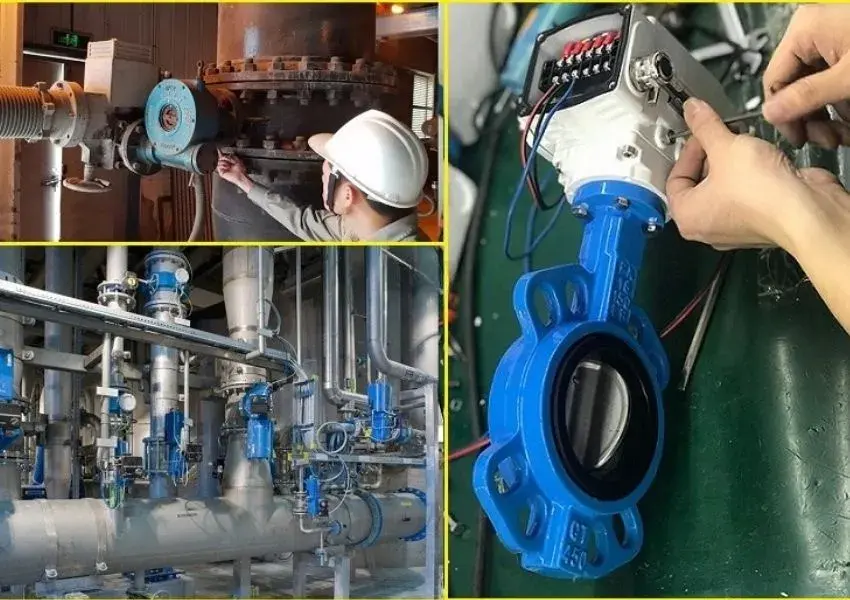
To ensure your electric actuated butterfly valve operates efficiently and durably, proper installation is crucial. Here are the basic steps:
Preparation Before Installation
Inadequate preparation can lead to leaks, reduced performance, equipment damage, or even potential safety hazards.
Here are the necessary preparation steps:
- Clean the pipeline: Before installation, completely remove all dust, residue, and foreign objects from inside the pipeline. You can use compressed air or specialized solutions to ensure unobstructed flow and prevent damage to the valve disc.
- Verify technical specifications: Compare the technical specifications of the valve with those of the piping system, such as nominal size (DN), working pressure (PN), material, temperature, and media type. Ensuring compatibility will facilitate quick installation and prevent technical errors.
- Inspect valve appearance and quality: Remove any foreign objects adhering to the valve’s surface. Carefully check components like the body, stem, disc, and seals for cracks, deformation, or manufacturing defects. Also, confirm the valve material is suitable for the operating conditions.
- Choose the installation location: Prioritize a well-ventilated location with enough space for operation, inspection, and maintenance. The valve must be installed in the correct flow direction and should not be stressed or distorted due to misaligned piping.
Prepare Necessary Tools and Materials:
This includes:
- Butterfly valve and flanges (if applicable).
- Bolts and gaskets (for both flange ends).
- Mechanical tools such as wrenches, pipe wrenches, and a welding machine (if welding flanges).
- Supports and lifting equipment (for large valves).
- Complete personal protective equipment (PPE): gloves, safety glasses, safety shoes, and appropriate safety attire.
Mechanical Installation Process
Even with automated equipment, even a minor misalignment during setup or an incorrectly tightened bolt can lead to leaks, reduced performance, and increased maintenance costs. Therefore, proper installation skill is a requirement that cannot be overlooked.
Here are the mechanical installation steps:
- Depressurise the System: Before starting any work, ensure the pipeline system is completely depressurised to avoid safety risks for the installer.
- Install Gaskets:
- For flanged valves: Use two gaskets, placing one between each pipe flange and the valve body.
- For wafer-style valves: These usually don’t need additional gaskets as they’re often integrated.
- Precisely align the bolt holes of the gaskets with the valve body and flanges.
- Position the Valve: Place the valve accurately between the two pipe flanges. Make sure the bolt holes align perfectly to prevent misalignment.
- Hand-Tighten Bolts Temporarily: Insert the bolts and hand-tighten them evenly to secure the valve. Don’t over-tighten at this stage; this helps avoid deformation or rubbing of the valve disc during subsequent steps.
- Tack Weld Flanges (if applicable): If using weld-neck flanges, lightly tack weld them to position. Avoid excessive heating, which can damage gaskets and sealing components.
- Temporarily Remove Valve (before final welding): After tack welding, remove the valve from the system. This prevents heat generated during the final welding process from deforming or burning the gaskets.
- Final Weld Flanges: Fully weld the flanges to the pipeline. Allow them to cool completely before re-installing the valve in its original position.
- Final Bolt Tightening: Tighten the bolts evenly in a crisscross pattern (or diagonally) to distribute the force uniformly. This prevents deformation of the connection surfaces and avoids leaks.
Installation Orientation Note:
The valve can be installed either horizontally or vertically. However, vertical installation (with a vertical shaft) is optimal—especially for larger valves—as it reduces the load on the shaft and the actuator.
Installation Distance Note:
If the valve is installed near pumps or other equipment, it’s advisable to leave a buffer space using a short pipe section or a flexible joint. This ensures the valve disc has enough room to open and close without obstruction.
Detailed Electrical Wiring Guide
Wiring an electric actuated butterfly valve requires high precision and absolute adherence to safety procedures. Errors in wiring can not only damage the equipment but also lead to short circuits, fires, or serious accidents.
Safety Principles Before You Begin:Electrical safety is the top priority. All wiring procedures must strictly follow the manufacturer’s technical diagrams and the electrical safety regulations at your workplace.
Here are the steps for electrical wiring:
- Completely Disconnect Power: This is a mandatory step before performing any work. You must ensure the system is entirely de-energised to protect the person performing the work and to prevent the risk of electrical discharge or fire/explosion.
- Use Correctly Rated Wires: Choose wires with a cross-section appropriate for the motor’s rated current. Wires that are too small can cause voltage drop, overheating, or equipment failure. The wires must have good insulation properties and be able to withstand the installation environment.
- Wire. According to the Manufacturer’s Diagram, each electric actuator will have its specific wiring diagram. You must follow this diagram precisely and not attempt to wire based on assumptions or prior experience.
Here’s an example for an ON/OFF valve:
- Wire 2: Neutral/Common wire
- Wire 3: Valve open signal
- Wire 4: Valve close signal
- To open the valve: Connect the power supply to wire 2 (Neutral/Common) and wire 3 (Valve open signal).
- To close the valve: Connect the power supply to wire 2 (Neutral/Common) and wire 4 (Valve close signal).
For Modulating/Linear Valves:
In addition to the power supply wires, you’ll need analogue control signal wires (typically for 4–20mA or 0–10V signals).
You may also require position feedback wires to the central control system (PLC, DCS, etc.) for real-time monitoring of the valve’s status.
4. Thoroughly Check Connections: After wiring is complete, re-check all terminals, tighten them securely, inspect the insulation, and eliminate any possibility of exposed contacts. Ensure all wires are firmly fixed, not loose or twisted.
5. Close the Actuator Cover: Once you’ve confirmed the wiring system is complete, securely close the actuator cover. This ensures the valve maintains its proper dust and water protection rating (IP65/IP67/IP68, depending on the model).
Technical Recommendation:Only trained technicians should perform electrical wiring. If you are unsure about the voltage configuration or control functions, you should contact the supplier for detailed instructions. Incorrect wiring can lead to motor burnout, travel faults, or circuit board damage—directly impacting the operation of the entire system.
Initial Operational Checks and Workplace Safety Notes
Initial operational checks are crucial for confirming that equipment functions as designed, promptly identifying any technical faults, and ensuring safety before the valve is put into actual service. Combined with regular maintenance, this is an indispensable part of industrial equipment management to maintain performance, extend lifespan, and limit operational issues.
Trial Operational Checks:
- For valves with manual handwheels: Try opening/closing the valve manually to check the smoothness of the transmission mechanism. The valve should not show any signs of sticking, stiffness, or travel deviation.
- For automatic control valves: Send signals from the control system or local controller to activate valve opening/closing. Ensure the disc’s rotation angle is accurate according to design specifications and that it responds to signals quickly and stably.
- Check for operational abnormalities: Observe and listen for any unusual noises or vibrations during operation. If you detect any abnormal signs, you need to disconnect the power, recheck the installation position, and all mechanical and electrical connections.
- Check for tightness and leaks: Inspect the entire valve body and flange connection points to ensure there are no media leaks. Even small leaks, if not addressed promptly, can damage the valve or affect operational safety.
Lubrication and Regular Maintenance:
- Lubricate moving joints or mechanical actuators regularly with grease or oil as recommended by the manufacturer.
- This helps reduce friction, prevent wear, inhibit rust, and maintain stable operating conditions over a long period.
Workplace Safety Notes:
- Always use full Personal Protective Equipment (PPE), including safety glasses, insulated gloves, non-slip footwear, and protective clothing, when working with valves and electrical systems.
- Strictly adhere to electrical safety regulations and site-specific work rules to prevent accidents and ensure the safety of both the system and personnel.
Key Considerations for Operating and Maintaining Electric Actuated Butterfly Valves
Proper maintenance of butterfly valves minimises damage, ensuring the system operates stably and efficiently.

Regular Maintenance
- To ensure optimal performance and longevity, regular maintenance of your electric actuated butterfly valve is essential.
- Make sure the actuator (electric motor) and all moving parts are cleaned regularly. Prevent dust and debris buildup, as these can obstruct the smooth operation of the valve.
- Periodically inspect the gaskets for wear, deformation, or damage. If a gasket is cracked, damaged, or has lost its elasticity, replace it immediately to ensure effective sealing and prevent leaks.
- Regularly lubricate the moving parts of the actuator with appropriate oil or grease. This reduces friction, ensures stable and quiet operation, and extends the life of the valve.
Common Troubleshooting
- Valve Jamming Due to Debris: This usually happens when dirt or impurities accumulate on the valve disc or in the actuator. If the valve fails to open or close, inspect and clean the internal components.
- Corroded Valve Disc: This occurs when the valve disc operates in a corrosive environment or is incompatible with the valve’s material. This can lead to leaks and requires timely replacement or repair.
- Motor Overload: If the control motor overheats or malfunctions, you need to inspect it and identify the cause. Sometimes, the motor overloads because the valve control is unsuitable for the application or due to excessive debris in the actuator.
Component Inspection and Replacement
- Gaskets can be damaged by temperature, pressure, or chemicals. Timely replacement of gaskets helps prevent fluid or gas leakage.
- The bearings of the actuator need to be checked to ensure they are not worn or lacking lubrication. Worn bearings can cause noise, increase friction, and reduce the valve’s lifespan.
- Regularly inspect the valve’s electrical system, including wiring, the controller, and connections, to ensure there are no electrical faults.
Refer to some butterfly valve products at Bao Tin Steel
Comparing Electric Actuated Butterfly Valves with Other Valve Types
To help you make an informed decision, let’s compare electric actuated butterfly valves with some other common industrial valve types:
Electric Control Butterfly Valve and Electric Control Gate Valve

Comparing Electric Control Butterfly Valves and Electric Control Gate Valves
| Criteria | Electric Butterfly Valve | Electric Gate Valve |
|---|---|---|
| Construction | Valve Disc: Round, rotates around an axis perpendicular to the flow. Valve Body: Wafer type (sandwiched between flanges) or Lug type (with bolt holes). Electric Actuator: Controls the valve shaft to rotate horizontally for opening/closing | Gate (Valve Disc): Rectangular or round, moves up and down perpendicular to the flow. Valve Body: Flanged type, bolted installation. Electric Actuator: Operates a screw shaft to lift/lower the gate |
| Sealing Performance | Not tight: The valve disc rotates, so there might still be a small gap at the sealing point. Suitable for: Applications where high sealing is not required or fluids with minimal leakage | High sealing performance: The gate presses tightly against the valve seat when fully closed. Suitable for: Systems requiring a perfect seal, straight flow, and hazardous fluids |
| Cost | Usually cheaper: Simple structure, uses fewer materials, especially for larger valves → lower cost | Usually more expensive: More complex structure, more components and materials → higher cost, especially for larger valves |
Electric Control Butterfly Valve and Electric Control Ball Valve

Comparison of butterfly valves and electric control ball valves
| Criteria | Electric Butterfly Valve | Electric Ball Valve |
|---|---|---|
| Advantages | – Simple construction, uses fewer materials → lower cost – Thin disc design → light valve, saves space – Easy operation, low power consumption → reduces operating costs, prolongs actuator lifespan | – Nearly perfect sealing when fully closed – Short opening/closing stroke (90 degrees) → quick response – The round ball doesn’t jam easily, stable operation |
| Disadvantages | – Sealing performance decreases with high pressure or worn seals. – High pressure can deform the disc or sealing gasket. Some areas are hard to clean thoroughly | – Higher cost due to premium materials – Small opening angle → less precise flow control – Larger size and weight compared to butterfly valves of the same size |
| Applications | – HVAC systems (heating, ventilation, air conditioning) – Water & wastewater treatment – Agricultural irrigation systems – Industrial applications: chemicals, textiles, food, paper, etc. | – Systems requiring high sealing: compressed air, hazardous chemicals, vacuum, potable water, food, pharmaceuticals – High-pressure systems: hydraulics, steam, oil and gas – Fire protection systems, emergency discharge, process automation |
Where to Buy Reputable Electric Control Butterfly Valves?
The market currently features many renowned brands manufacturing electric control butterfly valves, such as Adamant Valves, Asahi Yukizai, Belimo, KSB, and AVK, among others. Each brand’s products come with their strengths and limitations. The choice of which electric control butterfly valve to select, from which brand, and with what technical specifications, all depends on each customer’s specific needs and budget.
In Vietnam, Bao Tin Steel is one of the reputable distributors specializing in genuine electric control butterfly valves. When you purchase valves from Thép Bảo Tín, you can rest assured because they commit to:
- Clear Certificates of Origin (C.O.): Ensuring transparent and verifiable proof of the product’s origin.
- Manufacturer’s Quality Certificates (C.Q.): Providing guaranteed quality assurance directly from the manufacturer.
- Flexible Payment Policies: Offering various payment options to suit customer needs.
- Best Price Guarantee: Committing to the most competitive prices in the market.
- On-Time Delivery: Ensuring products are delivered according to the agreed schedule.
Besides industrial valves, Bao Tin Steel, with over 13 years of experience, also specialises in supplying steel pipes, pipe fittings, fire protection materials, and more. If you need any of these products, please contact them immediately via the following methods:

Bao Tin Steel Company Limited
Conclusion
The electric control butterfly valve is an optimal solution for automating operational processes, especially beneficial in industries demanding high continuity and precision. To select the right valve, you need to carefully consider factors such as size, material, control features (ON/OFF or linear), and ingress protection (IP) rating for water and dust. Additionally, regular maintenance is a crucial key to ensuring the equipment’s lifespan and performance.
We hope this article has provided valuable information for our customers and contractors before investing in and installing electric control butterfly valves for their projects.
If you have any questions or need ordering advice, don’t hesitate to contact us via Hotline: 0932 059 176!


 Tiếng Việt
Tiếng Việt ភាសាខ្មែរ
ភាសាខ្មែរ